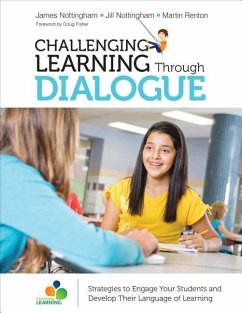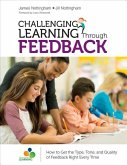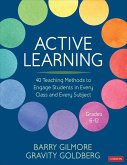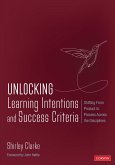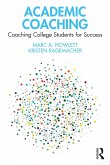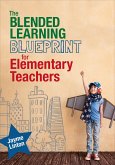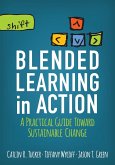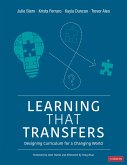James A. Nottingham, Jill Nottingham, Martin Renton
Challenging Learning Through Dialogue
Strategies to Engage Your Students and Develop Their Language of Learning
James A. Nottingham, Jill Nottingham, Martin Renton
Challenging Learning Through Dialogue
Strategies to Engage Your Students and Develop Their Language of Learning
- Broschiertes Buch
- Merkliste
- Auf die Merkliste
- Bewerten Bewerten
- Teilen
- Produkt teilen
- Produkterinnerung
- Produkterinnerung
Dialogue is one of the best vehicles for learning how to think, how to be reasonable, how to make moral decisions and how to understand another person's point of view. It is supremely flexible, instructional, collaborative and rigorous. At its very best, dialogue is one of the best ways for participants to learn good habits of thinking. There is also substantial evidence that teachers currently talk too much in classes, often only waiting .8 seconds after asking a question before jumping in with the answer if a student doesn't quickly volunteer. This book guides teachers through the different…mehr
Andere Kunden interessierten sich auch für
![Challenging Learning Through Feedback Challenging Learning Through Feedback]() James A. NottinghamChallenging Learning Through Feedback45,99 €
James A. NottinghamChallenging Learning Through Feedback45,99 €![Active Learning Active Learning]() Barry GilmoreActive Learning39,99 €
Barry GilmoreActive Learning39,99 €![Unlocking: Learning Intentions Unlocking: Learning Intentions]() Shirley ClarkeUnlocking: Learning Intentions32,99 €
Shirley ClarkeUnlocking: Learning Intentions32,99 €![Academic Coaching Academic Coaching]() Marc A. HowlettAcademic Coaching36,99 €
Marc A. HowlettAcademic Coaching36,99 €![The Blended Learning Blueprint for Elementary Teachers The Blended Learning Blueprint for Elementary Teachers]() Jayme LintonThe Blended Learning Blueprint for Elementary Teachers26,99 €
Jayme LintonThe Blended Learning Blueprint for Elementary Teachers26,99 €![Blended Learning in Action Blended Learning in Action]() Catlin R. TuckerBlended Learning in Action32,99 €
Catlin R. TuckerBlended Learning in Action32,99 €![Learning That Transfers Learning That Transfers]() Julie SternLearning That Transfers32,99 €
Julie SternLearning That Transfers32,99 €-
-
-
Dialogue is one of the best vehicles for learning how to think, how to be reasonable, how to make moral decisions and how to understand another person's point of view. It is supremely flexible, instructional, collaborative and rigorous. At its very best, dialogue is one of the best ways for participants to learn good habits of thinking. There is also substantial evidence that teachers currently talk too much in classes, often only waiting .8 seconds after asking a question before jumping in with the answer if a student doesn't quickly volunteer. This book guides teachers through the different types of dialogue and how they can be used to enhance students' learning.
Hinweis: Dieser Artikel kann nur an eine deutsche Lieferadresse ausgeliefert werden.
Hinweis: Dieser Artikel kann nur an eine deutsche Lieferadresse ausgeliefert werden.
Produktdetails
- Produktdetails
- Corwin Teaching Essentials
- Verlag: Corwin / Sage Publications
- Seitenzahl: 208
- Erscheinungstermin: 8. Februar 2017
- Englisch
- Abmessung: 279mm x 217mm x 15mm
- Gewicht: 581g
- ISBN-13: 9781506376523
- ISBN-10: 1506376525
- Artikelnr.: 46607311
- Herstellerkennzeichnung
- Libri GmbH
- Europaallee 1
- 36244 Bad Hersfeld
- gpsr@libri.de
- Corwin Teaching Essentials
- Verlag: Corwin / Sage Publications
- Seitenzahl: 208
- Erscheinungstermin: 8. Februar 2017
- Englisch
- Abmessung: 279mm x 217mm x 15mm
- Gewicht: 581g
- ISBN-13: 9781506376523
- ISBN-10: 1506376525
- Artikelnr.: 46607311
- Herstellerkennzeichnung
- Libri GmbH
- Europaallee 1
- 36244 Bad Hersfeld
- gpsr@libri.de
James Nottingham is co-founder and director of Challenging Learning, a group of companies with 30 employees in 6 countries. His passion is in transforming the most up-to-date research into strategies that really work in the classroom. He is regarded by many as one of the most engaging, thought-provoking and inspirational speakers in education. His first book, Challenging Learning, was published in 2010 and has received widespread critical acclaim. Since then, he has written 6 books for teachers, leaders, support staff, and parents. These books share the best research and practice connected with learning; dialogue; feedback; the learning pit; early years education; and growth mindset. Before training to be a teacher, James worked on a pig farm, in the chemical industry, for the American Red Cross, and as a teaching assistant in a school for deaf children. At university, he gained a first-class honours degree in education (a major turnaround after having failed miserably at school). He then worked as a teacher and leader in primary and secondary schools in the UK before co-founding an award-winning, multi-million-pound regeneration project supporting education, public and voluntary organisations across north east England. Skolvärlden (Swedish Teaching Union) describes James as "one of the most talked about names in the world of school development" and the Observer newspaper in the UK listed him among the Future 500 - a "definitive list of the UK′s most forward-thinking and brightest innovators."
List of Figures
The Challenging Learning Story
Foreword by Douglas Fisher
Acknowledgments
About the Authors
Contributors
Introduction
The Language of Learning
Chapter 1: Why Dialogue?
1.0 Why Dialogue?
1.1 Reasons for Dialogue 1: Learning How to Think
1.2 Reasons for Dialogue 2: From Surface to Deep
1.3 Reasons for Dialogue 3: Creating a Climate of Trust
1.4 Reasons for Dialogue 4: Developing Language to Express Understanding
1.5 Review
1.6 Next Steps
Chapter 2: Dialogue Essentials
2.0 Dialogue Basics
2.1 Putting Dialogue in the Context of Educational Objectives
2.2 The Hidden Classroom
2.3 Active Engagement
2.4 Conditions for Successful Dialogue
2.5 Language for Dialogue
2.6 Exploratory Talk
2.7 Review
2.8 Next Steps and Further Reading
Chapter 3: Dialogue to Engage Students
3.0 Preview
3.1 Getting the Ethos Right
3.2 Issuing Invitations
3.3 Encouraging and Engaging
3.4 Restating
3.5 Reformulating
3.6 Review
3.7 Next Steps and Further Reading
Chapter 4: One Way to Learn How to Think: Develop Reasoning
4.0 Preview
4.1 The Language of Reasoning
4.2 Developing the Language of Reasoning
4.3 Process of Reasoning
4.4 Routines to Develop Reasoning
4.5 Developing a Reasoning Repertoire
4.6 Reasoning Moves
4.7 Review
4.8 Next Steps
Chapter 5: Dialogue Groupings
5.0 Preview
5.1 Dialogue Groupings
5.2 Ground Rules for Dialogue Groups
5.3 Whole-Group Dialogue
5.4 Splitting Large Groups Into Two
5.5 Small-Group Dialogues With a Teacher
5.6 Small-Group Dialogues Without a Teacher
5.7 Final Word About Groupings
5.8 Review
5.9 Next Steps and Further Reading
Chapter 6: Dialogue Detectives
6.0 Preview
6.1 Appointing Dialogue Detectives
6.2 Clues to Detect: Focusing on Performance
6.3 Clues to Detect: Focusing on Thinking Structures
6.4 Other Clues to Detect
6.5 Review
6.6 Next Steps and Further Reading
Chapter 7: Dialogue Structures
7.0 Preview
7.1 Paired Dialogue
7.2 Opinion Lines
7.3 Opinion Corners
7.4 Choosing Corners
7.5 Talking Heads
7.6 Jigsaw Groups
7.7 Clustering
7.8 Review
7.9 Next Steps and Further Reading
Chapter 8: Mysteries
8.0 Preview
8.1 Mysteries
8.2 Running a Mystery
8.3 Mysteries in Practice
8.4 Questioning Cause and Effect Within Mysteries
8.5 Reviewing a Mystery Using the SOLO Taxonomy
8.6 Writing Your Own Mysteries
8.7 Review
8.8 Next Steps and Further Reading
8.9.1 Mystery: Should Bjørn Move to France?
8.9.2 Mystery: Louis Pasteur and the Anthrax Vaccine
8.9.3 Mystery: Is Sally a Good Friend?
Chapter 9: Odd One Out
9.0 Preview
9.1 Odd One Out
9.2 Benefits of Odd One Out
9.3 How to Use Odd One Out Effectively
9.4 Why and When to Use Odd One Out
9.5 Odd One Out Variations
9.6 Odd One Out Examples
9.7 Extending Odd One Out With Venn Diagrams
9.8 Review
9.9 Next Steps and Further Reading
Chapter 10: Fortune Lines
10.0 Preview
10.1 Fortune Lines
10.2 Using Fortune Lines
10.3 Fortune Line of Henry VIII
10.4 Fortune Line for a Visit to Grandma's
10.5 Review
10.6 Next Steps and Further Reading
Chapter 11: Philosophy for Children (P4C)
11.0 Preview
11.1 Philosophy for Children
11.2 The Community of Inquiry
11.3 Philosophical Questions
11.4 Dialogue Through P4C
11.5 P4C Sequence-Overview
11.6 P4C Sequence-In Depth
11.7 Review
11.8 Next Steps and Further Reading
Chapter 12: Dialogue Exercises in P4C
12.0 Preview
12.1 Dialogue Exercises
12.2 Make a Choice, Give a Reason
12.3 Concept Stretching: Fairness
12.4 Review
12.5 Next Steps and Further Reading
Appendix 1. Dialogue Detectives
Appendix 2. Louis Pasteur Script
Repertoire and Judgment Notes
References
Index
The Challenging Learning Story
Foreword by Douglas Fisher
Acknowledgments
About the Authors
Contributors
Introduction
The Language of Learning
Chapter 1: Why Dialogue?
1.0 Why Dialogue?
1.1 Reasons for Dialogue 1: Learning How to Think
1.2 Reasons for Dialogue 2: From Surface to Deep
1.3 Reasons for Dialogue 3: Creating a Climate of Trust
1.4 Reasons for Dialogue 4: Developing Language to Express Understanding
1.5 Review
1.6 Next Steps
Chapter 2: Dialogue Essentials
2.0 Dialogue Basics
2.1 Putting Dialogue in the Context of Educational Objectives
2.2 The Hidden Classroom
2.3 Active Engagement
2.4 Conditions for Successful Dialogue
2.5 Language for Dialogue
2.6 Exploratory Talk
2.7 Review
2.8 Next Steps and Further Reading
Chapter 3: Dialogue to Engage Students
3.0 Preview
3.1 Getting the Ethos Right
3.2 Issuing Invitations
3.3 Encouraging and Engaging
3.4 Restating
3.5 Reformulating
3.6 Review
3.7 Next Steps and Further Reading
Chapter 4: One Way to Learn How to Think: Develop Reasoning
4.0 Preview
4.1 The Language of Reasoning
4.2 Developing the Language of Reasoning
4.3 Process of Reasoning
4.4 Routines to Develop Reasoning
4.5 Developing a Reasoning Repertoire
4.6 Reasoning Moves
4.7 Review
4.8 Next Steps
Chapter 5: Dialogue Groupings
5.0 Preview
5.1 Dialogue Groupings
5.2 Ground Rules for Dialogue Groups
5.3 Whole-Group Dialogue
5.4 Splitting Large Groups Into Two
5.5 Small-Group Dialogues With a Teacher
5.6 Small-Group Dialogues Without a Teacher
5.7 Final Word About Groupings
5.8 Review
5.9 Next Steps and Further Reading
Chapter 6: Dialogue Detectives
6.0 Preview
6.1 Appointing Dialogue Detectives
6.2 Clues to Detect: Focusing on Performance
6.3 Clues to Detect: Focusing on Thinking Structures
6.4 Other Clues to Detect
6.5 Review
6.6 Next Steps and Further Reading
Chapter 7: Dialogue Structures
7.0 Preview
7.1 Paired Dialogue
7.2 Opinion Lines
7.3 Opinion Corners
7.4 Choosing Corners
7.5 Talking Heads
7.6 Jigsaw Groups
7.7 Clustering
7.8 Review
7.9 Next Steps and Further Reading
Chapter 8: Mysteries
8.0 Preview
8.1 Mysteries
8.2 Running a Mystery
8.3 Mysteries in Practice
8.4 Questioning Cause and Effect Within Mysteries
8.5 Reviewing a Mystery Using the SOLO Taxonomy
8.6 Writing Your Own Mysteries
8.7 Review
8.8 Next Steps and Further Reading
8.9.1 Mystery: Should Bjørn Move to France?
8.9.2 Mystery: Louis Pasteur and the Anthrax Vaccine
8.9.3 Mystery: Is Sally a Good Friend?
Chapter 9: Odd One Out
9.0 Preview
9.1 Odd One Out
9.2 Benefits of Odd One Out
9.3 How to Use Odd One Out Effectively
9.4 Why and When to Use Odd One Out
9.5 Odd One Out Variations
9.6 Odd One Out Examples
9.7 Extending Odd One Out With Venn Diagrams
9.8 Review
9.9 Next Steps and Further Reading
Chapter 10: Fortune Lines
10.0 Preview
10.1 Fortune Lines
10.2 Using Fortune Lines
10.3 Fortune Line of Henry VIII
10.4 Fortune Line for a Visit to Grandma's
10.5 Review
10.6 Next Steps and Further Reading
Chapter 11: Philosophy for Children (P4C)
11.0 Preview
11.1 Philosophy for Children
11.2 The Community of Inquiry
11.3 Philosophical Questions
11.4 Dialogue Through P4C
11.5 P4C Sequence-Overview
11.6 P4C Sequence-In Depth
11.7 Review
11.8 Next Steps and Further Reading
Chapter 12: Dialogue Exercises in P4C
12.0 Preview
12.1 Dialogue Exercises
12.2 Make a Choice, Give a Reason
12.3 Concept Stretching: Fairness
12.4 Review
12.5 Next Steps and Further Reading
Appendix 1. Dialogue Detectives
Appendix 2. Louis Pasteur Script
Repertoire and Judgment Notes
References
Index
List of Figures
The Challenging Learning Story
Foreword by Douglas Fisher
Acknowledgments
About the Authors
Contributors
Introduction
The Language of Learning
Chapter 1: Why Dialogue?
1.0 Why Dialogue?
1.1 Reasons for Dialogue 1: Learning How to Think
1.2 Reasons for Dialogue 2: From Surface to Deep
1.3 Reasons for Dialogue 3: Creating a Climate of Trust
1.4 Reasons for Dialogue 4: Developing Language to Express Understanding
1.5 Review
1.6 Next Steps
Chapter 2: Dialogue Essentials
2.0 Dialogue Basics
2.1 Putting Dialogue in the Context of Educational Objectives
2.2 The Hidden Classroom
2.3 Active Engagement
2.4 Conditions for Successful Dialogue
2.5 Language for Dialogue
2.6 Exploratory Talk
2.7 Review
2.8 Next Steps and Further Reading
Chapter 3: Dialogue to Engage Students
3.0 Preview
3.1 Getting the Ethos Right
3.2 Issuing Invitations
3.3 Encouraging and Engaging
3.4 Restating
3.5 Reformulating
3.6 Review
3.7 Next Steps and Further Reading
Chapter 4: One Way to Learn How to Think: Develop Reasoning
4.0 Preview
4.1 The Language of Reasoning
4.2 Developing the Language of Reasoning
4.3 Process of Reasoning
4.4 Routines to Develop Reasoning
4.5 Developing a Reasoning Repertoire
4.6 Reasoning Moves
4.7 Review
4.8 Next Steps
Chapter 5: Dialogue Groupings
5.0 Preview
5.1 Dialogue Groupings
5.2 Ground Rules for Dialogue Groups
5.3 Whole-Group Dialogue
5.4 Splitting Large Groups Into Two
5.5 Small-Group Dialogues With a Teacher
5.6 Small-Group Dialogues Without a Teacher
5.7 Final Word About Groupings
5.8 Review
5.9 Next Steps and Further Reading
Chapter 6: Dialogue Detectives
6.0 Preview
6.1 Appointing Dialogue Detectives
6.2 Clues to Detect: Focusing on Performance
6.3 Clues to Detect: Focusing on Thinking Structures
6.4 Other Clues to Detect
6.5 Review
6.6 Next Steps and Further Reading
Chapter 7: Dialogue Structures
7.0 Preview
7.1 Paired Dialogue
7.2 Opinion Lines
7.3 Opinion Corners
7.4 Choosing Corners
7.5 Talking Heads
7.6 Jigsaw Groups
7.7 Clustering
7.8 Review
7.9 Next Steps and Further Reading
Chapter 8: Mysteries
8.0 Preview
8.1 Mysteries
8.2 Running a Mystery
8.3 Mysteries in Practice
8.4 Questioning Cause and Effect Within Mysteries
8.5 Reviewing a Mystery Using the SOLO Taxonomy
8.6 Writing Your Own Mysteries
8.7 Review
8.8 Next Steps and Further Reading
8.9.1 Mystery: Should Bjørn Move to France?
8.9.2 Mystery: Louis Pasteur and the Anthrax Vaccine
8.9.3 Mystery: Is Sally a Good Friend?
Chapter 9: Odd One Out
9.0 Preview
9.1 Odd One Out
9.2 Benefits of Odd One Out
9.3 How to Use Odd One Out Effectively
9.4 Why and When to Use Odd One Out
9.5 Odd One Out Variations
9.6 Odd One Out Examples
9.7 Extending Odd One Out With Venn Diagrams
9.8 Review
9.9 Next Steps and Further Reading
Chapter 10: Fortune Lines
10.0 Preview
10.1 Fortune Lines
10.2 Using Fortune Lines
10.3 Fortune Line of Henry VIII
10.4 Fortune Line for a Visit to Grandma's
10.5 Review
10.6 Next Steps and Further Reading
Chapter 11: Philosophy for Children (P4C)
11.0 Preview
11.1 Philosophy for Children
11.2 The Community of Inquiry
11.3 Philosophical Questions
11.4 Dialogue Through P4C
11.5 P4C Sequence-Overview
11.6 P4C Sequence-In Depth
11.7 Review
11.8 Next Steps and Further Reading
Chapter 12: Dialogue Exercises in P4C
12.0 Preview
12.1 Dialogue Exercises
12.2 Make a Choice, Give a Reason
12.3 Concept Stretching: Fairness
12.4 Review
12.5 Next Steps and Further Reading
Appendix 1. Dialogue Detectives
Appendix 2. Louis Pasteur Script
Repertoire and Judgment Notes
References
Index
The Challenging Learning Story
Foreword by Douglas Fisher
Acknowledgments
About the Authors
Contributors
Introduction
The Language of Learning
Chapter 1: Why Dialogue?
1.0 Why Dialogue?
1.1 Reasons for Dialogue 1: Learning How to Think
1.2 Reasons for Dialogue 2: From Surface to Deep
1.3 Reasons for Dialogue 3: Creating a Climate of Trust
1.4 Reasons for Dialogue 4: Developing Language to Express Understanding
1.5 Review
1.6 Next Steps
Chapter 2: Dialogue Essentials
2.0 Dialogue Basics
2.1 Putting Dialogue in the Context of Educational Objectives
2.2 The Hidden Classroom
2.3 Active Engagement
2.4 Conditions for Successful Dialogue
2.5 Language for Dialogue
2.6 Exploratory Talk
2.7 Review
2.8 Next Steps and Further Reading
Chapter 3: Dialogue to Engage Students
3.0 Preview
3.1 Getting the Ethos Right
3.2 Issuing Invitations
3.3 Encouraging and Engaging
3.4 Restating
3.5 Reformulating
3.6 Review
3.7 Next Steps and Further Reading
Chapter 4: One Way to Learn How to Think: Develop Reasoning
4.0 Preview
4.1 The Language of Reasoning
4.2 Developing the Language of Reasoning
4.3 Process of Reasoning
4.4 Routines to Develop Reasoning
4.5 Developing a Reasoning Repertoire
4.6 Reasoning Moves
4.7 Review
4.8 Next Steps
Chapter 5: Dialogue Groupings
5.0 Preview
5.1 Dialogue Groupings
5.2 Ground Rules for Dialogue Groups
5.3 Whole-Group Dialogue
5.4 Splitting Large Groups Into Two
5.5 Small-Group Dialogues With a Teacher
5.6 Small-Group Dialogues Without a Teacher
5.7 Final Word About Groupings
5.8 Review
5.9 Next Steps and Further Reading
Chapter 6: Dialogue Detectives
6.0 Preview
6.1 Appointing Dialogue Detectives
6.2 Clues to Detect: Focusing on Performance
6.3 Clues to Detect: Focusing on Thinking Structures
6.4 Other Clues to Detect
6.5 Review
6.6 Next Steps and Further Reading
Chapter 7: Dialogue Structures
7.0 Preview
7.1 Paired Dialogue
7.2 Opinion Lines
7.3 Opinion Corners
7.4 Choosing Corners
7.5 Talking Heads
7.6 Jigsaw Groups
7.7 Clustering
7.8 Review
7.9 Next Steps and Further Reading
Chapter 8: Mysteries
8.0 Preview
8.1 Mysteries
8.2 Running a Mystery
8.3 Mysteries in Practice
8.4 Questioning Cause and Effect Within Mysteries
8.5 Reviewing a Mystery Using the SOLO Taxonomy
8.6 Writing Your Own Mysteries
8.7 Review
8.8 Next Steps and Further Reading
8.9.1 Mystery: Should Bjørn Move to France?
8.9.2 Mystery: Louis Pasteur and the Anthrax Vaccine
8.9.3 Mystery: Is Sally a Good Friend?
Chapter 9: Odd One Out
9.0 Preview
9.1 Odd One Out
9.2 Benefits of Odd One Out
9.3 How to Use Odd One Out Effectively
9.4 Why and When to Use Odd One Out
9.5 Odd One Out Variations
9.6 Odd One Out Examples
9.7 Extending Odd One Out With Venn Diagrams
9.8 Review
9.9 Next Steps and Further Reading
Chapter 10: Fortune Lines
10.0 Preview
10.1 Fortune Lines
10.2 Using Fortune Lines
10.3 Fortune Line of Henry VIII
10.4 Fortune Line for a Visit to Grandma's
10.5 Review
10.6 Next Steps and Further Reading
Chapter 11: Philosophy for Children (P4C)
11.0 Preview
11.1 Philosophy for Children
11.2 The Community of Inquiry
11.3 Philosophical Questions
11.4 Dialogue Through P4C
11.5 P4C Sequence-Overview
11.6 P4C Sequence-In Depth
11.7 Review
11.8 Next Steps and Further Reading
Chapter 12: Dialogue Exercises in P4C
12.0 Preview
12.1 Dialogue Exercises
12.2 Make a Choice, Give a Reason
12.3 Concept Stretching: Fairness
12.4 Review
12.5 Next Steps and Further Reading
Appendix 1. Dialogue Detectives
Appendix 2. Louis Pasteur Script
Repertoire and Judgment Notes
References
Index
"We know that teachers do too much of the talking in the classroom, and they know it too. But too often their first question is How do we get students to talk more? Nottingham, Nottingham and Renton have helped answer that question. Challenging Learning is filled with practical advice and important activities that will help increase dialogue in classrooms!" Peter DeWitt, Author/Consultant

